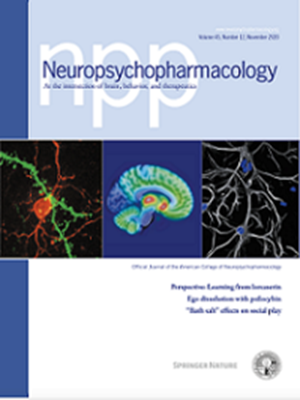β-抑制素2在吗啡和新型阿片受体激动剂kurkinorin和kurkinol的抗痛觉性和副作用中的作用。
IF 6.6
1区 医学
Q1 NEUROSCIENCES
引用次数: 0
摘要
开发更安全、副作用更小的mu阿片受体(MOR)激动剂是疼痛研究的一个重点。一些研究表明,减少β-阻滞蛋白2 (βArr2)信号的MOR激动剂(即g蛋白偏向激动剂)可能具有更大的治疗窗口。然而,有一些相互矛盾的报道,并且不清楚βArr2信号在mor介导的镇痛、耐受性或副作用中起什么作用,如果有的话。因此,我们利用βArr2基因敲除小鼠,系统地研究了βArr2信号在吗啡和两种新型MOR激动剂kurkinorin和kurkinol诱导的抗伤性、抗伤性耐受、呼吸抑制、便秘和奖励中的因果作用。Kurkinorin和kurkinol表现出强大的抗伤害感受作用,被MOR敲除逆转。与吗啡或kurkinorin不同,我们最具g蛋白偏向的激动剂kurkinol在给药~2×ED50 7天后没有表现出明显的耐受性。然而,在化疗诱导的神经性疼痛模型中,所有三种化合物在~ED50剂量20天后无效,表明耐受。所有化合物都表现出明显的摩尔依赖副作用,尽管与吗啡相比,kurkinorin表现出较少的g蛋白偏倚,但其胃肠道和呼吸抑制作用减少。敲除βArr2可显著增加小鼠对吗啡和kurkinorin的抗痛觉效力,但对kurkinorin无显著影响,除此之外对耐受性或任何副作用均无显著影响。这些结果在很大程度上表明,βArr2信号不能驱动mor介导的抗伤害性耐受性、呼吸抑制、便秘或奖励,也不支持将g蛋白偏倚化合物作为减少副作用的广泛有效策略的发展。本文章由计算机程序翻译,如有差异,请以英文原文为准。

Role of β-Arrestin 2 in the antinociceptive and side effect profile of morphine and the novel mu opioid receptor agonists, kurkinorin and kurkinol
The development of safer mu opioid receptor (MOR) agonists with reduced side effects is a key focus of pain research. Some studies have suggested that MOR agonists with reduced β-arrestin 2 (βArr2) signaling (i.e. G-protein biased agonists) may have greater therapeutic windows. However, there have been a several conflicting reports, and it is not clear what role, if any, βArr2 signaling plays in MOR-mediated analgesia, tolerance, or side effects. Therefore, we used βArr2 knockout mice to systematically investigate the causal role of βArr2 signaling in antinociception, antinociceptive tolerance, respiratory depression, constipation, and reward induced by morphine and the two novel MOR agonists, kurkinorin and kurkinol. Kurkinorin and kurkinol exhibited potent antinociceptive effects that were reversed by MOR knockout. Unlike morphine or kurkinorin, our most G-protein biased agonist, kurkinol, showed no significant tolerance after seven days of ~2×ED50 dosing. However, in a chemotherapy-induced neuropathic pain model, all three compounds were ineffective after 20 days of ~ED50 dosing, indicative of tolerance. All compounds exhibited significant MOR-dependent side effects, though kurkinorin had reduced gastrointestinal and respiratory depressive effects compared to morphine despite exhibiting less G-protein bias. Knockout of βArr2 significantly increased antinociceptive potency for morphine and kurkinorin but not kurkinol, and otherwise had no significant impact on tolerance or any side effect tested. These results largely suggest that βArr2 signaling does not drive MOR-mediated antinociceptive tolerance, respiratory depression, constipation, or reward and do not support the development of G-protein biased compounds as a broadly effective strategy to reduce side effects.
求助全文
通过发布文献求助,成功后即可免费获取论文全文。
去求助
来源期刊

Neuropsychopharmacology
医学-精神病学
CiteScore
15.00
自引率
2.60%
发文量
240
审稿时长
2 months
期刊介绍:
Neuropsychopharmacology is a reputable international scientific journal that serves as the official publication of the American College of Neuropsychopharmacology (ACNP). The journal's primary focus is on research that enhances our knowledge of the brain and behavior, with a particular emphasis on the molecular, cellular, physiological, and psychological aspects of substances that affect the central nervous system (CNS). It also aims to identify new molecular targets for the development of future drugs.
The journal prioritizes original research reports, but it also welcomes mini-reviews and perspectives, which are often solicited by the editorial office. These types of articles provide valuable insights and syntheses of current research trends and future directions in the field of neuroscience and pharmacology.
 求助内容:
求助内容: 应助结果提醒方式:
应助结果提醒方式:


